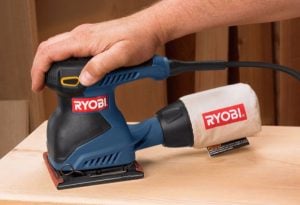[AdSense-A]Palm sanders have become one of the favorite types of sanders for all word working professionals and enthusiasts alike. The portability, ease of use, and the versatility that makes it perfect for nearly every job makes it a must have for all. Sometimes known as finishing sanders, palm sanders is a one-handed power tool and sands in a circular orbit which makes it a great choice for finishing and sanding corners.
When looking at the many sanders you can choose from, knowing specifically how to use it will definitely give you the desired effect. If you decide to take matters into your own hands without reading the following steps on how to use a palm sander you could cause injury or end up damaging what’s being sanded.
Consider Safety First and Gather Materials
One of the most overlooked aspects of sanding is safety. Taking the small amount of time to done proper safety equipment such as a mask, goggles, and ear protection may prove to be much more valuable than you thought. Unfortunate incidents always happen to those who don’t exactly expect it, and the majority of incidents are 100% avoidable.
Be sure to gather all of your materials before use including the sander itself, sand paper, dry cloth, and safety equipment. Making sure you are working in a well-ventilated room will help reduce dust and other particles and you can take it one step further and consider purchasing a palm sander with the ability to adapt a vacuuming system.
Choosing the Right Sandpaper Grit
The sandpaper grit makes all the difference with any sanding job including drywall, wood, vehicles, and anything else you can imagine. Sandpaper grit comes in various numbers ranging between 60 – 280 with the lower, coarser number reserved for tougher jobs while the higher numbers are better suited for finer jobs such as finishing.
For tougher jobs such as rough wood, start out with a 60 -80 grit sandpaper. After a couple of passes, switch the paper to a finer grit being sure to stay in progression and not skipping over grit. All it should take is a few passes with each grit of sandpaper before finishing up with a 280 grit paper for a smooth, desired finish.
The idea of the step process in sandpaper allows for the removal of scratches left by the previous grit of sand paper used, so don’t get worried if you see scratches during the sanding process.
Inserting the Sandpaper
Palm sanders use a 1/3 or ¾ sheet of sandpaper. How the paper attaches to the sander depends on the specific model, but most are attached using the attached clamp on two sides of the sander. Always start off with the coarser sandpaper, either a 60 grit paper for tough jobs or an 80 grit paper for others.
Allow the Sander and Sandpaper to do all the Work
One of the biggest misconceptions with sanding is that people believe to get the best results and to reduce time relies heavily on the amount of force which is exerted. The sanding process should be completely natural which means the sander and sandpaper will do all the work. The amount of force is light to moderate and should never be forcefully emitted from person to tool.
Also, when using a palm sander you should always sand with the grain of the material. For instance, wood has a natural grain which is very easy to see to the naked eye, and sanding against the grain will produce undesirable scratches. Sand using long, even strokes and never move back and forth repeatedly over the same area as this will also cause scratches and divots.
Wipe and Switch Grit Sandpaper
Typically, it only takes a couple of passes with each sandpaper before you end of switching the sandpaper from one grit to another. This may vary slightly with tougher jobs, but the amount of passes should be marginal.
Be sure to wipe down the material being sanded prior to sanding with a different grit of paper. Use a dry cloth which will help get rid of sanding dust and other particles before sanding with a finer grit paper. Repeat this process through each grit of paper until you finish up with a 280 grit paper and the smooth surface to your liking.
[AdSense-A]





